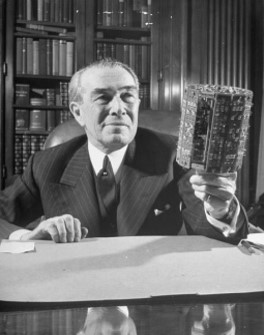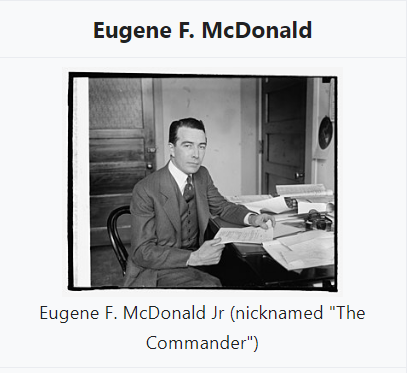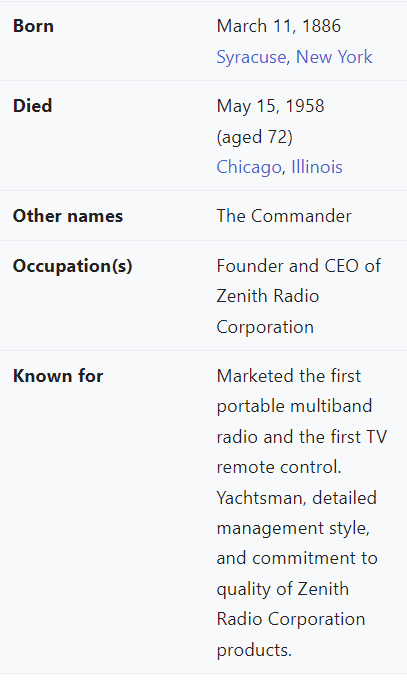Eugene McDonald -- Zenith Radio Corporation

Click for PDF version of Eugene McDonald -- Zenith Radio Corporation -- Biography
Introduction
 Picture of Eugene McDonald -- Zenith Radio Corporation
Picture of Eugene McDonald -- Zenith Radio Corporation
 Eugene McDonald Life Stats -- Zenith Radio Corporation
Eugene McDonald Life Stats -- Zenith Radio Corporation
Eugene F. McDonald Wikipedia Page
Eugene McDonald was born on March 11, 1888, in Syracuse, New York. After graduation from high school, he worked for Franklin Manufacturing Company "an early automobile manufacturer" (p. 69). In 1910 McDonald moved to Chicago and started his own unsuccessful company "in the automobile self-starter business" (p. 69). He continued working in the automobile business in 1912, "buying Ford automobiles for cash and selling them on the installment plan" (p. 69). McDonald enlisted in the Navy in 1917. By the end of WWI, McDonald "had risen to the rank of Lieutenant Commander in Naval Intelligence" (p. 70). After the war, "he remained active as a naval reserve officer" (p. 70).
"Shortly after returning from military service" (p. 70), McDonald heard his first radio broadcast on New Years Eve in 1920. He was fascinated with radio, and after researching the radio receiver industry he decided to enter the business. Because he was unable to obtain the license needed to build patented receivers, he decided to join a firm that already had a license. R.H.G. Mathews and Karl Hassel owned the Chicago Radio Laboratory and had the license McDonald sought. They operated 9ZN, an amateur radio station and also manufactured their own radio sets with the brand name Z-Nith.
In 1921 McDonald offered to provide Mathews and Hassel with funds to expand their business. In return McDonald would serve as general manager of Chicago Radio Laboratory. "On June 30, 1923, a marketing organization called the Zenith Radio Corporation was incorporated with McDonald as one of the shareholders. Zenith became the exclusive sales agent for the products manufactured by Chicago Radio Laboratory" (p. 71). Zenith eventually became a manufacturer and it acquired Chicago Radio Laboratories assets. In 1922 Zenith built a transmitter and began broadcasting as radio station WJAZ from the Edgewater Beach Hotel.
McDonald felt broadcasting could either be financed through advertising or "government ownership and subsidization" (p. 71). McDonald chose a unique way to advertise. He found a radio magazine publisher who would donate $1,000 to the National Association of Broadcasters and allow McDonald to sell the magazines on the air. Announcers read articles and told their listeners where to purchase the magazine. When the magazine sold out, the publisher agreed to continue advertising. "So far as can be determined, that was the first regular merchandising program conducted over a group of stations" (p. 72-73).
By 1925 McDonald's business strategy for Zenith was clear. He wanted to produce high quality merchandise with strict quality control measures, and target the high price market segment. To promote this image, the slogan "The Quality Goes In Before The Name Goes On" (p. 73) was adopted. To assure that products met this standard before they left the factory Mr. G.B. Baca was placed in charge of the Final Inspection Department. Baca was an Ex-Marine who answered directly to McDonald and was concerned only with quality, not production quotas. As McDonald described the situation, "I create the standard-he maintains it" (p. 73).
McDonald further described his business strategy for Zenith in a letter to one of his distributors: "To an opportunist the temptation would be strong to push up production rapidly, slight the quality and get the money while the season is on. But we are not opportunists. We are not in this business for just the present and for next year. We are building a name-a reputation-and it is our hope that we shall always be behind in our orders because of increased demand for quality product" (p. 74).
When the Great Depression began in the fall of 1929, "the radio industry was especially hard hit. Price competition combined with a greatly reduced volume of sales to impose losses on most of the firms in the industry, and many eventually went bankrupt. Zenith struggled through five years of losses but managed to survive" (p. 74).
In Zenith's 1930 annual report, McDonald explained "following the market crash our shipments dropped off immediately to the smallest in our history at that time of the year. . . This situation was met by bringing out a new line of receivers, which enabled us to liquidate our inventory, pay our trade creditors and our bank loans fifteen days before they were due" (p. 75). In both the 1931 and 1933 annual report, McDonald discussed his concerns about competition referring to "the competition of irresponsible transient manufacturers" (p. 76) who "flooded the market with inferior goods at ridiculously low prices"(p. 76).
By 1934, Zenith was finally able to report a profit, due to "outstanding merchandise, low overhead, improved wholesale outlets, and motor car radios" (p. 77). McDonald stated that the growth in demand for car radios would "enable our plants to operate on normal schedule practically the entire year" (p. 77).
Even during the Great Depression, McDonald sought new technology that would benefit Zenith in the future. Zenith "became the leading firm producing FM and AM receivers" (p. 79). On February 2, 1940, Zenith began its first broadcast on its own FM station and used the station to "promote the concept of FM" (p. 78). By 1960 Zenith had 40 percent of the market.
An article in Fortune magazine in June of 1945, detailed McDonald's accomplishments. It stated: "Zenith is one of the three or four companies that have survived from the beginnings of the industry in the early 1920s. And it had not merely survived. From tenth or twelfth place in a $400 million industry in the late 1920s it shot up past R.C.A. and claimed second place in the $600 million industry of 1941. Now it is training its guns on Philco. How Zenith did it is not a simple story, but it can be epitomized by a simple story. One Saturday it occurred to McDonald that hand controls for auto radios were dangerous and he dictated a memo to his engineering department suggesting ideas for a foot control. On Monday he started a patent search and had his engineers build a rough working model for his own car. On Tuesday he tried it, and on Wednesday he sent it to Detroit. On Thursday he went to Detroit and talked up the device to Edsel Ford and George Mason (Nash-Kelvinator). That night he was back in Chicago with Ford and Nash in the bag. Several people doubtless thought of foot controls before McDonald; the point is that McDonald saw its possibilities and lost no time in using them. Simply on the basis of its record from 1934 to 1942, Zenith has good claim to being the nation's outstanding set-manufacturing company, and McDonald to being the industry's star executive" (p. 80-81).
In 1931, Zenith began research on television, but did not sell television receivers until 1948. McDonald explained this delay in a May 16, 1994, press release. "Until standards are fixed. . . money paid out for a television receiver is money thrown out of the window. . . In Chicago, television was introduced to the public in 1928 by radio station WCFL. . . and in 1939 by Chicago Daily News Station WMAQ. . . more than a thousand receivers were sold in the Chicago area. They are useless today. . . Television receivers sold as late as 1940 shared the fate of the earlier ones. Their screens remain dark. . . I make this point to tell how vital it is to adopt standards. . . so that we may have good life expectancy in television receivers and the public may get its money's worth when it buys one. I am sure neither our stockholders nor I want quick profits from television receivers foreknowingly built to die in their first few years" (p. 82). Although Zenith only had 6 percent of the total market as late as 1956, "three years later it had 18 percent of the market and had passed R.C.A. to become the firm with the largest share of the market" (p. 82).
McDonald used the same strategy with color television. Although Zenith engineers began working on color television in 1940, McDonald refused to enter the market, stating that the 3-gun color tube used by R.C.A. at the time was a "'Rube Goldberg' device that would eventually be made obsolete by a technically superior product" (p. 84). His distributors wanted to enter the market, but McDonald told them "we at Zenith believe it is much better to do research work in the laboratory than to experiment on the public" (p. 85).
Zenith introduced color television in 1961, and by 1969 was within 2 percentage points of R.C.A., the industry leader. In 1971, "Zenith passed R.C.A. to become the number one seller of television in the American market" (p. 85). Eugene McDonald did not live to see Zenith's success with color television, he died in 1958.
This article was written by Dr. Richard Hattwick.
*Copyright 2002. The American National Business Hall of Fame. All rights reserved. No portion of ANBHF may be duplicated, redistributed or manipulated without the expressed permission of the ANBHF.
Copyright 2001 American National Business Hall of Fame. All Rights Reserved.


